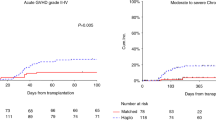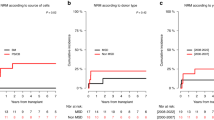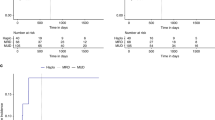Abstract
We analysed the outcome and hospitalization requirements of the first 100 patients (Hodgkin's disease (HD), N=13; multiple myeloma (MM), N=14; CLL, N=12; non-Hodgkin's lymphoma (NHL), N=17; myelodysplastic syndrome (MDS), N=18; AML, N=24 and CML, N=2) treated in Denmark with haematopoietic cell transplantation after non-myeloablative conditioning with TBI 2 Gy±fludarabine. The cumulative incidence of acute GVHD grade II–IV and extensive chronic GVHD was 67 and 49%. After a median follow-up of 534 days, the overall survival, PFS, relapse-related mortality and treatment-related mortality were 59, 50, 25 and 17%, respectively. Patients with CLL, NHL, AML and MDS with <5% blasts at any time had a favourable outcome with a PFS of 61–71%. Patients with MM, HD and MDS and a history of ⩾5% blasts had a less favourable outcome with a PFS of 19–38% (P=0.001). The cumulative incidence of discontinuation of immunosuppression was 37%. During the first and second year post transplant, patients experienced a mean of 41 and 13 outpatient clinic visits, and 53 and 16 days of hospitalization. Sixteen patients were admitted to the intensive care unit, of whom eight are still alive. In conclusion, transplantation outcomes were encouraging, but complications requiring admission and outpatient clinic visits occur frequently post transplant.
This is a preview of subscription content, access via your institution
Access options
Subscribe to this journal
Receive 12 print issues and online access
$259.00 per year
only $21.58 per issue
Buy this article
- Purchase on Springer Link
- Instant access to full article PDF
Prices may be subject to local taxes which are calculated during checkout



Similar content being viewed by others
References
Baron F, Sandmaier BM . Current status of hematopoietic stem cell transplantation after nonmyeloablative conditioning. Curr Opin Hematol 2005; 12: 435–443.
Baron F, Storb R . Allogeneic hematopoietic cell transplantation following nonmyeloablative conditioning as treatment for hematologic malignancies and inherited blood disorders. Mol Ther 2006; 13: 26–41.
Meijer E, Dekker AW, Lokhorst HM, Petersen EJ, Nieuwenhuis HK, Verdonck LF . Low incidence of infectious complications after nonmyeloablative compared with myeloablative allogeneic stem cell transplantation. Transpl Infect Dis 2004; 6: 171–178.
Sorror ML, Maris MB, Storer B, Sandmaier BM, Diaconescu R, Flowers C et al. Comparing morbidity and mortality of HLA-matched unrelated donor hematopoietic cell transplantation after nonmyeloablative and myeloablative conditioning: influence of pretransplantation comorbidities. Blood 2004; 104: 961–968.
Diaconescu R, Flowers CR, Storer B, Sorror ML, Maris MB, Maloney DG et al. Morbidity and mortality with nonmyeloablative compared with myeloablative conditioning before hematopoietic cell transplantation from HLA-matched related donors. Blood 2004; 104: 1550–1558.
McSweeney PA, Niederwieser D, Shizuru JA, Sandmaier BM, Molina AJ, Maloney DG et al. Hematopoietic cell transplantation in older patients with hematologic malignancies: replacing high-dose cytotoxic therapy with graft-versus-tumor effects. Blood 2001; 97: 3390–3400.
Weissinger F, Sandmaier BM, Maloney DG, Bensinger WI, Gooley T, Storb R . Decreased transfusion requirements for patients receiving nonmyeloablative compared with conventional peripheral blood stem cell transplants from HLA-identical siblings. Blood 2001; 98: 3584–3588.
Hogan WJ, Maris M, Storer B, Sandmaier BM, Maloney DG, Schoch HG et al. Hepatic injury after nonmyeloablative conditioning followed by allogeneic hematopoietic cell transplantation: a study of 193 patients. Blood 2004; 103: 78–84.
Parikh CR, Schrier RW, Storer B, Diaconescu R, Sorror ML, Maris MB et al. Comparison of ARF after myeloablative and nonmyeloablative hematopoietic cell transplantation. Am J Kidney Dis 2005; 45: 502–509.
Fukuda T, Hackman RC, Guthrie KA, Sandmaier BM, Boeckh M, Maris MB et al. Risks and outcomes of idiopathic pneumonia syndrome after nonmyeloablative and conventional conditioning regimens for allogeneic hematopoietic stem cell transplantation. Blood 2003; 102: 2777–2785.
Chien JW, Maris MB, Sandmaier BM, Maloney DG, Storb RF, Clark JG . Comparison of lung function after myeloablative and 2 Gy of total body irradiation-based regimens for hematopoietic stem cell transplantation. Biol Blood Marrow Transplant 2005; 11: 288–296.
Mielcarek M, Martin PJ, Leisenring W, Flowers ME, Maloney DG, Sandmaier BM et al. Graft-versus-host disease after nonmyeloablative versus conventional hematopoietic stem cell transplantation. Blood 2003; 102: 756–762.
Flowers MED, Traina F, Storer B, Maris M, Bethge WA, Carpenter P et al. Serious graft-versus-host disease after hematopoietic cell transplantation following nonmyeloablative conditioning. Bone Marrow Transplant 2004; 35: 277–282.
Junghanss C, Boeckh M, Carter RA, Sandmaier BM, Maris MB, Maloney DG et al. Incidence and outcome of cytomegalovirus infections following nonmyeloablative compared with myeloablative allogeneic stem cell transplantation, a matched control study. Blood 2002; 99: 1978–1985.
Junghanss C, Marr KA, Carter RA, Sandmaier BM, Maris MB, Maloney DG et al. Incidence and outcome of bacterial and fungal infections following nonmyeloablative compared with myeloablative allogeneic hematopoietic stem cell transplantation: a matched control study. Biol Blood Marrow Transplant 2002; 8: 512–520.
Petersen SL, Madsen HO, Ryder LP, Svejgaard A, Jakobsen BK, Sengelov H et al. Haematopoietic stem cell transplantation with non-myeloablative conditioning in the outpatient setting: results, complications and admission requirements in a single institution. Br J Haematol 2004; 125: 225–231.
Cordonnier C, Maury S, Esperou H, Pautas C, Beaune J, Rodet M et al. Do minitransplants have minicosts? A cost comparison between myeloablative and nonmyeloablative allogeneic stem cell transplant in patients with acute myeloid leukemia. Bone Marrow Transplant 2005; 36: 649–654.
Baron F, Baker JE, Storb R, Gooley TA, Sandmaier BM, Maris MB et al. Kinetics of engraftment in patients with hematologic malignancies given allogeneic hematopoietic cell transplantation after nonmyeloablative conditioning. Blood 2004; 104: 2254–2262.
Maris MB, Sandmaier BM, Storer BE, Maloney DG, Shizuru JA, Agura E et al. Unrelated donor granulocyte colony-stimulating factor-mobilized peripheral blood mononuclear cell transplantation after nonmyeloablative conditioning: the effect of postgrafting mycophenolate mofetil dosing. Biol Blood Marrow Transplant 2006; 12: 454–465.
Mielcarek M, Storb R . Graft-vs-host disease after non-myeloablative hematopoietic cell transplantation. Leuk Lymphoma 2005; 46: 1251–1260.
Perez-Simon JA, ez-Campelo M, Martino R, Brunet S, Urbano A, Caballero MD et al. Influence of the intensity of the conditioning regimen on the characteristics of acute and chronic graft-versus-host disease after allogeneic transplantation. Br J Haematol 2005; 130: 394–403.
Sullivan KM . Graft-vs-host disease. In: Blume KG, Forman SJ, Appelbaum FR (eds). Thomas' Hematopoietic Cell Transplantation, 3rd edn. Blackwell: Malden, MA, 2003, pp 635–664.
Gooley TA, Leisenring W, Crowley J, Storer BE . Estimation of failure probabilities in the presence of competing risks: new representations of old estimators. Stat Med 1999; 18: 695–706.
Gray RJ . A class of k-sample tests for comparing the cumulative incidence of a competing risk. Ann Stat 1988; 16: 1141–1154.
Feinstein LC, Sandmaier BM, Hegenbart U, McSweeney PA, Maloney DG, Gooley TA et al. Non-myeloablative allografting from human leucocyte antigen-identical sibling donors for treatment of acute myeloid leukaemia in first complete remission. Br J Haematol 2003; 120: 281–288.
Maloney DG, Molina AJ, Sahebi F, Stockerl-Goldstein KE, Sandmaier BM, Bensinger W et al. Allografting with nonmyeloablative conditioning following cytoreductive autografts for the treatment of patients with multiple myeloma. Blood 2003; 102: 3447–3454.
Georges GE, Maris MB, Maloney DG, Sandmaier BM, Sorror ML, Shizuru JA et al. Nonmyeloablative unrelated donor hematopoietic cell transplantation to treat patients with poor-risk, relapsed, or refractory multiple myeloma. Biol Blood Marrow Transplant 2007; 13: 423–432.
Burroughs L, Mielcarek M, Leisenring W, Sandmaier BM, Maloney DG, Baron F et al. Extending postgrafting cyclosporine decreases the risk of severe graft-versus-host disease after nonmyeloablative hematopoietic cell transplantation. Transplantation 2006; 81: 818–825.
Sandmaier BM, Maris M, Maloney DG, Gooley TA, Stuart MJ, Hegenbart U et al. Low-dose total body irradiation (TBI) conditioning for hematopoietic cell transplants (HCT) from HLA-matched related (MRD) and unrelated (URD) donors for patients with hematologic malignancies: a five-year experience. Blood 2003; 102: 78a–79a.
Dreger P, Brand R, Hansz J, Milligan D, Corradini P, Finke J et al. Treatment-related mortality and graft-versus-leukemia activity after allogeneic stem cell transplantation for chronic lymphocytic leukemia using intensity-reduced conditioning. Leukemia 2003; 17: 841–848.
Khouri IF, Lee MS, Saliba RM, Andersson B, Anderlini P, Couriel D et al. Nonablative allogeneic stem cell transplantation for chronic lymphocytic leukemia: impact of rituximab on immunomodulation and survival. Exp Hematol 2004; 32: 28–35.
Sorror ML, Maris MB, Sandmaier BM, Storer BE, Stuart MJ, Hegenbart U et al. Hematopoietic cell transplantation after nonmyeloablative conditioning for advanced chronic lymphocytic leukemia. J Clin Oncol 2005; 23: 3819–3829.
Delgado J, Thomson K, Russell N, Ewing J, Stewart W, Cook G et al. Results of alemtuzumab-based reduced-intensity allogeneic transplantation for chronic lymphocytic leukemia: a British Society of Blood and Marrow Transplantation study. Blood 2006; 107: 1724–1730.
Robinson SP, Goldstone AH, Mackinnon S, Carella A, Russell N, de Elvira CR et al. Chemoresistant or aggressive lymphoma predicts for a poor outcome following reduced-intensity allogeneic progenitor cell transplantation: an analysis from the Lymphoma Working Party of the European Group for Blood and Bone Marrow Transplantation. Blood 2002; 100: 4310–4316.
Morris E, Thomson K, Craddock C, Mahendra P, Milligan D, Cook G et al. Outcomes after alemtuzumab-containing reduced-intensity allogeneic transplantation regimen for relapsed and refractory non-Hodgkin lymphoma. Blood 2004; 104: 3865–3871.
Corradini P, Zallio F, Mariotti J, Farina L, Bregni M, Valagussa P et al. Effect of age and previous autologous transplantation on nonrelapse mortality and survival in patients treated with reduced-intensity conditioning and allografting for advanced hematologic malignancies. J Clin Oncol 2005; 23: 6690–6698.
Alyea EP, Kim HT, Ho V, Cutler C, DeAngelo DJ, Stone R et al. Impact of conditioning regimen intensity on outcome of allogeneic hematopoietic cell transplantation for advanced acute myelogenous leukemia and myelodysplastic syndrome. Biol Blood Marrow Transplant 2006; 12: 1047–1055.
de Lima M, Anagnostopoulos A, Munsell M, Shahjahan M, Ueno N, Ippoliti C et al. Nonablative versus reduced-intensity conditioning regimens in the treatment of acute myeloid leukemia and high-risk myelodysplastic syndrome: dose is relevant for long-term disease control after allogeneic hematopoietic stem cell transplantation. Blood 2004; 104: 865–872.
Aoudjhane M, Labopin M, Gorin NC, Shimoni A, Ruutu T, Kolb HJ et al. Comparative outcome of reduced intensity and myeloablative conditioning regimen in HLA identical sibling allogeneic haematopoietic stem cell transplantation for patients older than 50 years of age with acute myeloblastic leukaemia: a retrospective survey from the Acute Leukemia Working Party (ALWP) of the European group for Blood and Marrow Transplantation (EBMT). Leukemia 2005; 19: 2304–2312.
Scott BL, Sandmaier BM, Storer B, Maris MB, Sorror ML, Maloney DG et al. Myeloablative vs nonmyeloablative allogeneic transplantation for patients with myelodysplastic syndrome or acute myelogenous leukemia with multilineage dysplasia: a retrospective analysis. Leukemia 2006; 20: 128–135.
Peggs KS, Hunter A, Chopra R, Parker A, Mahendra P, Milligan D et al. Clinical evidence of a graft-versus-Hodgkin's-lymphoma effect after reduced-intensity allogeneic transplantation. Lancet 2005; 365: 1934–1941.
Crawley C, Lalancette M, Szydlo R, Gilleece M, Peggs K, Mackinnon S et al. Outcomes for reduced-intensity allogeneic transplantation for multiple myeloma: an analysis of prognostic factors from the Chronic Leukaemia Working Party of the EBMT. Blood 2005; 105: 4532–4539.
Nieto Y, Patton N, Hawkins T, Spearing R, Bearman SI, Jones RB et al. Tacrolimus and mycophenolate mofetil after nonmyeloablative matched-sibling donor allogeneic stem-cell transplantations conditioned with fludarabine and low-dose total body irradiation. Biol Blood Marrow Transplant 2006; 12: 217–225.
Saito AM, Zahrieh D, Cutler C, Ho VT, Antin JH, Soiffer RJ et al. Lower costs associated with hematopoietic cell transplantation using reduced intensity vs high-dose regimens for hematological malignancy. Bone Marrow Transplant 2007; 40: 209–217.
Lim Z, Pagliuca A, Simpson S, Cottam S, Ervine M, Ho AY et al. Outcomes of patients with haematological malignancies admitted to intensive care unit. A comparative review of allogeneic haematopoietic stem cell transplantation data. Br J Haematol 2007; 136: 448–450.
Acknowledgements
We thank the medical, nursing and laboratory staff of the participating departments for their contribution to this study. We also thank Mrs Anne Bjørlig for excellent technical assistance. This study was supported with grants from the Danish Medical Research Council, Novo Nordisk Research Foundation, Benzon Foundation, Danish Cancer Society, Lundbeck Foundation and Rigshospitalet. BK is a Rigshospitalet research fellow.
Author information
Authors and Affiliations
Corresponding author
Rights and permissions
About this article
Cite this article
Kornblit, B., Masmas, T., Madsen, H. et al. Haematopoietic cell transplantation with non-myeloablative conditioning in Denmark: disease-specific outcome, complications and hospitalization requirements of the first 100 transplants. Bone Marrow Transplant 41, 851–859 (2008). https://doi.org/10.1038/bmt.2008.10
Received:
Revised:
Accepted:
Published:
Issue Date:
DOI: https://doi.org/10.1038/bmt.2008.10



